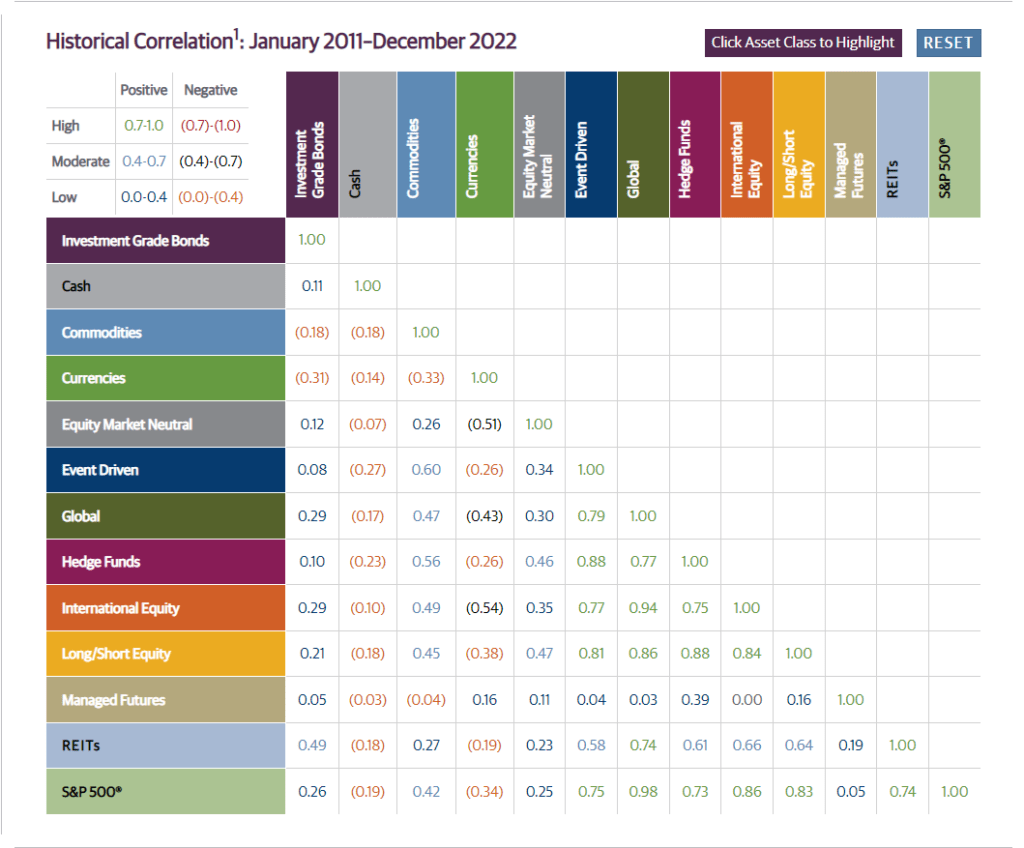This post may contain affiliate links. We may receive compensation when you click on links to those products at no additional cost to you. Read our full disclosure here.
Once upon a time, there was a farmer named Jack who had a large plot of land where he grew only one crop – wheat. Jack had been growing wheat for many years, and it had always been a successful crop for him. However, one year, a drought hit the area, and Jack’s entire wheat crop was destroyed. He had no other crops to fall back on, and as a result, he faced financial ruin.
Feeling desperate, Jack decided to diversify his farm by planting different crops. He started growing corn, beans, and potatoes, among other things. Even though a drought hit again and his wheat died, other crops were doing fine and he was able to weather future droughts and other challenges by relying on his diverse range of crops.
This story illustrates the importance of diversification, not just in agriculture, but also in diversification in finance and investing. When we put all our eggs in one basket like in just one investment, we run the risk of losing everything if that investment thing fails. Diversification in finance allows us to spread our risk and increase our chances of success, even in the face of unexpected challenges.
KEY TAKEAWAYS
- Diversification in finance means spreading investments across a variety of assets with low to no correlation to reduce risk and volatility.
- The two main ways to measure diversification are asset allocation and correlation. A well-diversified portfolio should include investments that are not closely correlated with each other.
- There are several ways to diversify your investment portfolio, including asset allocation, sector diversification, geographic diversification, and investment style diversification.
What is Diversification in Finance
Diversification in finance refers to the practice of spreading investments across a variety of assets with low to no correlation to reduce risk and volatility. How does that work?
- When investments are highly correlated, they tend to move in the same direction, which means that if one investment performs poorly, other investments may also perform poorly.
- By diversifying your investments across assets that are not highly correlated, you can reduce the overall risk of your portfolio.
- This is because if one investment performs poorly, others may not be affected as much or may even perform well, helping to offset any losses.
- It is important to note that diversification doesn’t guarantee you’ll make money or avoid losing money, but it can help make your overall investments less risky and more likely to make money in the long run.

How to Measure Diversification
The two main ways to measure diversification in finance are asset allocation and correlation. A well-diversified portfolio should include investments that are not closely correlated with each other.
Asset Allocation
The most simplistic way to measure diversification is to look at the allocation of your assets across different categories. A well-diversified portfolio should have a balanced allocation across multiple asset classes.
For example, suppose you have a portfolio that is 50% invested in stocks, 30% in bonds, and 20% in real estate. In that case, you may be considered well-diversified because your portfolio is spread out across multiple asset classes.
Correlation
The second and most common way to measure diversification is by measuring the correlation between investments in your portfolio. This is because just having multiple asset classes may not mean you are actually diversified.
Diversification is not only about spreading your investments across different asset classes but also about selecting investments that are not closely correlated with each other. This means that when one investment performs poorly, others may perform better and help to balance out the overall performance of the portfolio.
The best way to measure the correlation between assets is to create a correlation matrix. However, this may require you to source a ton of historical data of the investments and also the expertise to load it into excel and run a correlation matrix.
The good news is there are a ton of free resources to track the correlation between asset classes like the one below from Guggenheim Investments.

As you can see in the chart above, some asset classes are more highly correlated with others and not so much with others. Your goal for diversification is to choose investments that have a low to no correlation to others, and weight them in your portfolio according to your goals and objectives.
The Benefits of Diversification
Diversification offers a number of benefits for investors, including:
- Risk Reduction: Diversification can help to reduce the overall risk of your portfolio by spreading your investments across different asset classes. If one asset class underperforms, the others may help to offset the losses.
- Increased Return Potential: By diversifying your investments across different asset classes, you may be able to increase your overall return potential. This is because different asset classes tend to perform well at different times, so by having a mix of assets, you may be able to capture gains from different market conditions.
- Protection Against Volatility: Diversification can also help to protect against market volatility. During periods of market turbulence, some asset classes may perform better than others, so by having a diversified portfolio, you can potentially reduce the impact of market volatility on your investments.
Potential Drawbacks of Diversification
While diversification can offer a number of benefits for investors, there are also potential drawbacks to consider, including:
- Lower Returns: Diversification can potentially reduce your returns if one or more of your investments perform very well. In this case, the gains from the outperforming investment may not be enough to offset the losses from the other investments.
- Increased Complexity: Diversification can make your investment portfolio more complex and difficult to manage. This is because you may need to keep track of multiple investments across different asset classes, sectors, and geographic regions.
- Higher Fees: Diversification can also result in higher fees, as you may need to invest in multiple funds or hire a financial advisor to manage your portfolio.
- Systematic risks: Systematic risks are risks that affect the entire market or economy, and cannot be avoided and/or mitigated by diversification. Systematic risks include inflation, changes in interest rates, natural disasters, or political events that can cause everyone to lose money, no matter how they invested.
Ways to Diversify Your Portfolio
There are several ways to diversify your investment portfolio. The most common methods include:
- Asset Allocation: Asset allocation involves dividing your investment portfolio among different asset classes, such as stocks, bonds, and cash. The proportion of your portfolio that you allocate to each asset class will depend on your investment goals, risk tolerance, and time horizon.
- Sector Diversification: Sector diversification involves investing in different industries or sectors. For example, you might invest in technology stocks for growth, healthcare stocks to be more defensive, and energy stocks to hedge inflation to spread your investments across different sectors.
- Geographic Diversification: Geographic diversification involves investing in companies or assets located in different countries or regions. This can help to reduce the risk of your portfolio being impacted by events in a single country or region like war, legal issues, or natural disasters
- Investment Style Diversification: Investment style diversification involves investing in different investment styles, such as growth stocks, value stocks, and dividend stocks. This can help to reduce the risk of your portfolio being impacted by changes in market conditions that favor one investment style over another.
Impact of Diversification
So how does diversification actually reduce my portfolio’s risk? Let’s check out an example of diversification below assuming we are using assets with low to no correlation with each other:
| Portfolio | Portfolio Mix | Return | Risk-free rate | Standard Deviation | Sharpe Ratio |
| 1 | 100% Asset A | 10.00% | 2% | 15.00% | 0.53 |
| 2 | 50% Asset A, 50% Asset B | 8.00% | 2% | 10.00% | 0.60 |
| 3 | 33.33% Asset A, 33.33% Asset B, 33.33% Asset C | 7.00% | 2% | 7.00% | 0.714 |
| 4 | 25% Asset A, 25% Asset B, 25% Asset C, 25% Asset D | 6.5% | 2% | 4.50% | 1.00 |
Some thoughts:
- The return column in a table shows how much money the portfolio made during a certain time.
- The standard deviation column shows the variability of the return during that time.
- This tells us how risky the portfolio is as the higher the variability = the more uncertain the outcome = the riskier it is.
- The Sharpe ratio column is calculated by subtracting the risk-free rate from the return and dividing that by the risk (standard deviation). This shows you how much you made per unit of risk.
- The Sharpe ratio is a measure of how well a portfolio performs in terms of both returns and risk. It calculates a score for each portfolio based on these two factors.
- Simply having a high return on your portfolio is not enough. If the portfolio is too risky, it could easily lose value and negate any gains made from high returns.
- The Sharpe ratio considers both the return and the risk of a portfolio, and the higher the Sharpe ratio, the better the risk-return profile is.
- In other words, a higher Sharpe ratio means that the portfolio is generating higher returns relative to the amount of risk taken, making it a better investment choice.
In the table, portfolio 4 has the lowest return and risk, but it also has the highest Sharpe ratio. This means that it had the best risk-adjusted return involved thanks to the power of diversification – see how the Sharpe ratio goes up as we add more investments to the portfolio.
Conclusion
Diversification is an important tool for investors seeking to reduce idiosyncratic risks in their portfolios. This can be achieved by spreading investments across various assets, sectors, and regions, potentially reducing the effects of market volatility on the portfolio.
Investors should consider developing a diversified portfolio that is in line with their investment goals, risk tolerance, and time horizon, and seek guidance from financial advisors to create a personalized investment plan.
FAQ
How many assets should I have in my diversified portfolio?
There is no set number of assets that you should have in your diversified portfolio. The key is to have a mix of different assets that aligns with your investment goals, risk tolerance, and time horizon.
Can diversification guarantee that I won’t lose money?
No, diversification cannot guarantee that you won’t lose money. While diversification can help to mitigate risks, there is always the possibility of unexpected events occurring that can cause your investments to lose value.
Is diversification only important for long-term investors?
No, diversification is important for investors of all time horizons. Whether you’re a short-term or long-term investor, diversification can help to mitigate risks and potentially increase your return potential.
How often should I review my diversified portfolio
It’s a good idea to review your diversified portfolio on a regular basis, such as once a year or whenever your investment goals, risk tolerance, or time horizon changes.
The opinions expressed in this article are for general information purposes only and are not intended to provide specific advice or recommendations about any investment product or security. If you have questions pertaining to your individual situation you should consult your financial advisor.
This post may contain affiliate links. We may receive compensation when you click on links to those products at no additional cost to you. Read our full disclosure here.






